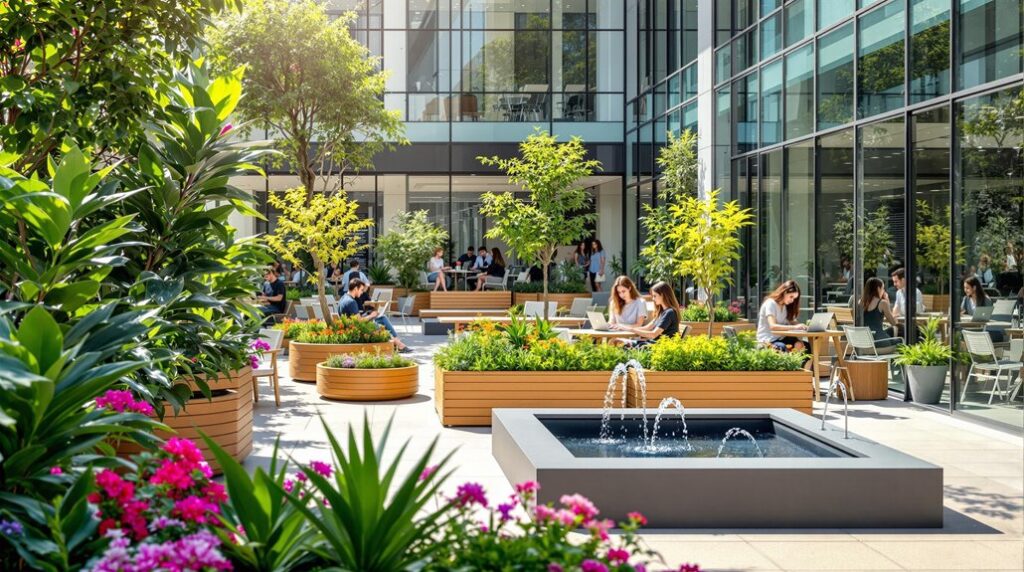I’ve discovered that most office productivity solutions focus on technology and furniture, but they’re missing an essential element that’s literally growing right outside your window. When I started designing outdoor garden spaces for workplaces, I noticed something remarkable: employees weren’t just taking breaks differently—they were thinking differently. The strategic placement of plants, herbs, and quiet zones created an environment where focus and creativity flourished in ways that surprised even me.
Key Takeaways
- Position air-purifying plants near workstations for 15% productivity boost and improved air quality through NASA-recommended varieties.
- Create multi-sensory outdoor innovation spaces with aromatic herbs and bird-attracting plants to enhance team creativity by 15%.
- Install garden pods like Hypedome models for focused work sanctuaries with natural light and distraction-free environments.
- Design collaborative outdoor zones with modular workstations and weather-resistant whiteboards for spontaneous brainstorming and problem-solving acceleration.
- Implement living walls and vertical gardens to filter 80% of airborne toxins while providing natural insulation and energy savings.
Strategic Plant Placement for Maximum Work Output
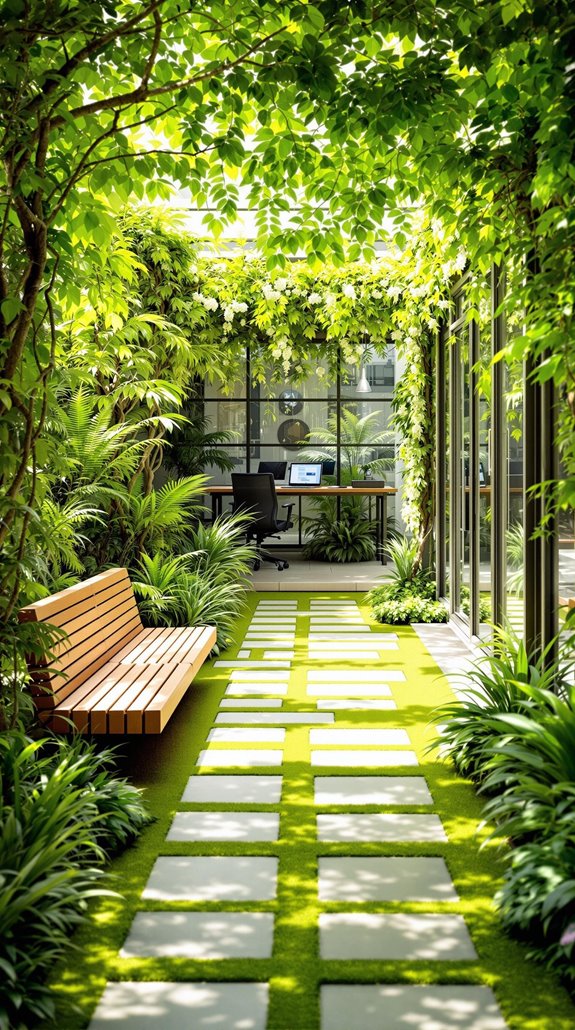
When you strategically position plants throughout your office, you’re not just adding decoration—you’re implementing a productivity tool that directly impacts your team’s performance. I’ve found that placing greenery near workstations creates immediate visual relief while improving air quality for daily tasks. You’ll want to position compact desk plants within arm’s reach—this guarantees 85% of your employees get consistent exposure during core work hours without overwhelming their personal workspace.
Transform those dead corner spaces with floor-standing specimens that become vibrant focal points. I recommend clustering plants in collaborative areas where your team brainstorms, as this naturally encourages creativity and spontaneous idea-sharing. Don’t overlook window sills—they’ll brighten employee sightlines while utilizing natural light. Your lounge areas need plant groupings too, promoting relaxation during breaks when productivity resets. Understanding your plant species requirements ensures long-term success and prevents the disappointment of watching expensive greenery deteriorate in unsuitable conditions.
Creative Garden Zones That Spark Innovation
Beyond simply placing plants around workstations, you’ll want to design dedicated garden zones that actively fuel your team’s creative thinking. I recommend creating multi-sensory innovation spaces that engage different cognitive pathways. Plant aromatic herbs like lavender to stimulate creativity through scent—it’s scientifically linked to cognitive relaxation. Including innovative storage solutions can also enhance the overall functionality of these spaces. Add bird-attracting plants like coneflowers for visual dynamism during restorative micro-breaks. Install kinetic sculptures or wind-activated art pieces for passive visual stimulation that keeps minds engaged. Use contrasting colors in your bloom cycles to subconsciously boost alertness and idea generation.
Equip these zones with weather-resistant whiteboards for spontaneous idea capture, and consider motion-activated lighting to extend creative sessions into evening hours without energy waste. Design comfortable seating areas where employees can take 15-17 minute breaks to reset their focus and enhance performance between intensive work sessions.
Air-Purifying Plants for Healthier Work Environments
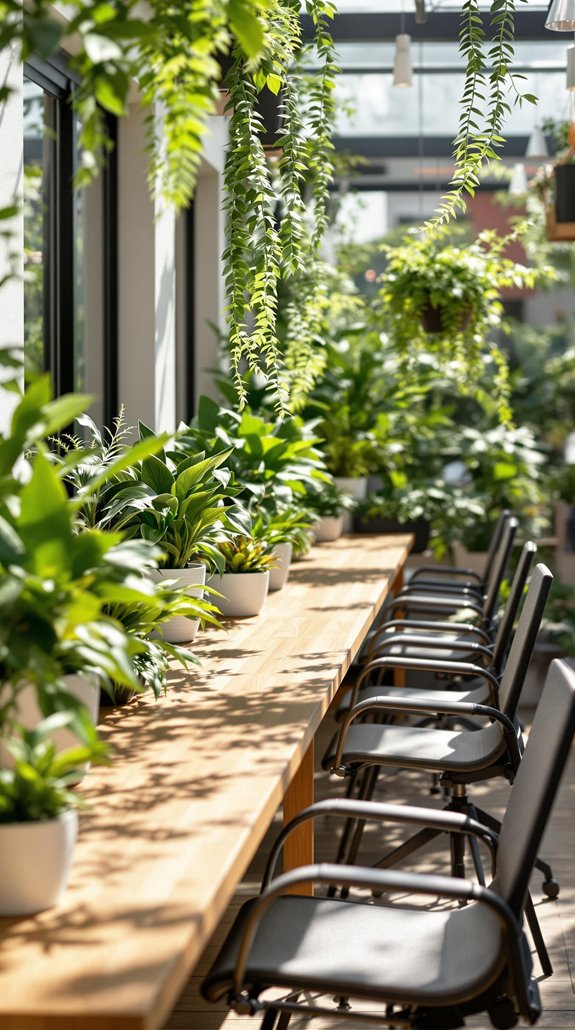
Transforming your office into a healthier workspace starts with selecting the right air-purifying plants that’ll actually remove toxins while thriving in typical office conditions. I’ve found that choosing low-light species creates the foundation for success, especially in windowless areas where most office workers spend their days.
You’ll want to focus on NASA-recommended varieties that target specific pollutants like VOCs and formaldehyde. I recommend positioning these green allies within your direct line of sight—research shows this placement delivers a 15% productivity boost while reducing health symptoms by 21%. Incorporating elements such as soft textiles can also enhance the overall comfort of your workspace, making it a more inviting environment.
Creating “green zones” with multiple plants amplifies their air-cleaning power. Pair them with your existing ventilation system for maximum impact. The key is selecting compact, low-maintenance options that won’t overwhelm your workspace but will consistently purify your air. These plants also transform CO2 into oxygen throughout the day, continuously improving your breathing environment.
Quiet Garden Pods for Deep Focus Sessions
Garden pods represent the next evolution in focused work environments, taking the air-purifying benefits of office plants and amplifying them within a dedicated outdoor sanctuary. I’ve discovered that these structures create the perfect deep work zone you’ve been searching for.
The Hypedome model costs €7,704 and lasts fifteen years with minimal maintenance. You’ll appreciate how easily it sets up and takes down when your workspace needs change. The 2.3-meter height provides comfortable headroom while maintaining a compact footprint for any garden space.
What makes these pods exceptional is their ability to eliminate household distractions completely. You’ll experience improved focus, regulated circadian rhythms from natural light exposure, and reduced stress levels. The physical separation signals to family members that you’re unavailable, protecting your concentration during critical work sessions. These garden offices also serve as excellent spaces for sending sensitive communications without the risk of interruptions or eavesdropping.
Collaborative Garden Spaces for Team Building

While individual focus pods excel at deep work, your team’s creative breakthrough moments happen when colleagues gather in thoughtfully designed outdoor spaces that blend natural elements with collaborative functionality. I recommend installing flexible modular workstations that you can reconfigure for brainstorming sessions, paired with digital whiteboards and video conferencing tools that deliver 20-30% productivity gains.
Create casual meeting zones with movable seating around fire pits or communal kitchens where organic conversations flourish. These outdoor “third spaces” reduce stress while accelerating problem-solving, and the greenery exposure boosts your team’s creativity by 15%. You’ll strengthen team cohesion through shared experiences in nature-integrated breakout areas that serve double duty as training venues and social event spaces. The incorporation of plants and natural elements also improves air quality by absorbing carbon dioxide and releasing oxygen, creating a healthier environment for extended collaborative sessions.
Ergonomic Outdoor Seating Solutions
When designing outdoor workspaces that’ll actually get used, you need seating that delivers both ergonomic support and weather resistance without breaking your budget. I’ve found that investing in multipurpose ergonomic chairs pays off—they accommodate more workers with less overhead while reducing the 63% of office workers who experience extreme discomfort from poor seating.
Your outdoor seating solutions should prioritize adjustability and durability. Look for weather-resistant materials that maintain comfort across seasons while supporting proper posture to prevent musculoskeletal disorders. Since 25% of remote workers struggle finding adequate workspace, you’re filling a real need.
The key is balancing cost-effectiveness with functionality. Choose designs that work both indoors and out, maximizing your investment while creating spaces where your team actually wants to collaborate and focus. Research shows that outdoor work environments can enhance cognitive functions and overall well-being when properly designed with supportive infrastructure.
Living Walls and Vertical Garden Systems
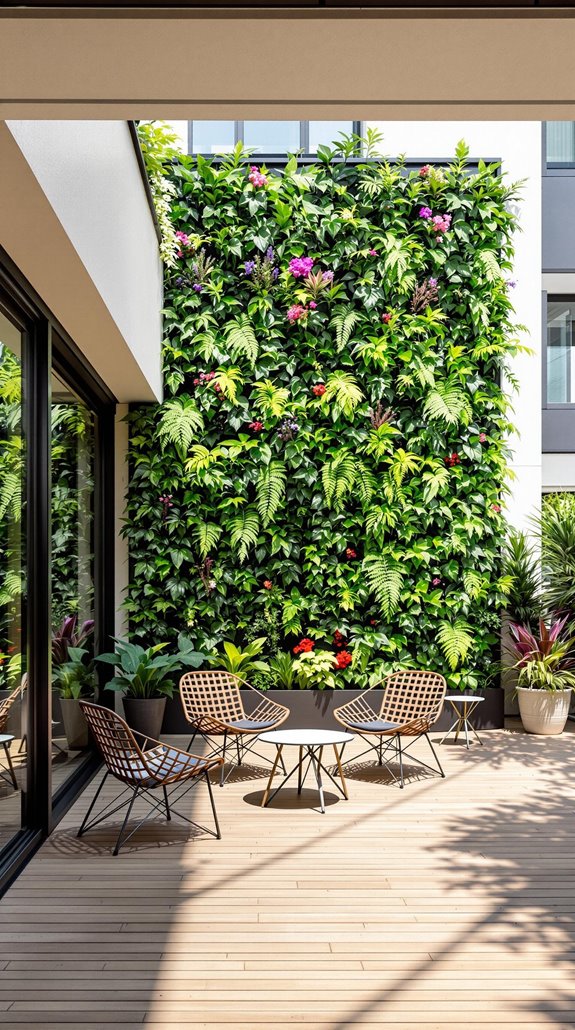
Since traditional office plants can’t deliver the dramatic air-purifying impact your workspace needs, living walls and vertical garden systems offer a powerful solution that transforms bare walls into productive green infrastructure. I’ve seen these systems filter up to 80% of airborne toxins while boosting creativity by 15% through biophilic design principles. Additionally, implementing energy-efficient choices in your office environment can further enhance these benefits.
You’ll want to prioritize native, drought-resistant species with automated irrigation systems for minimal maintenance. I recommend modular panels in high-traffic areas like atriums where air circulation maximizes benefits. When lighting constraints limit plant viability, balance live elements with artificial options that still provide visual appeal.
The investment pays off quickly—energy savings of 20-40% through natural insulation, plus property value increases of 7-15%, delivering ROI within 2-5 years. For offices seeking low maintenance options, moss walls provide the aesthetic benefits of vertical gardens without requiring soil, water, or sunlight.
Aromatherapy Gardens for Stress Relief
Although traditional office stress management relies on expensive wellness programs and break room upgrades, aromatherapy gardens deliver measurable cortisol reduction and cognitive enhancement through strategically placed aromatic plants.
I’ll position lavender and rosemary near desks where you’ll inhale their calming scents throughout your workday. For creative blocks, I recommend adding Hens and Chicks or Cypress Vine to boost idea generation by 15%. You can create designated meditation zones surrounded by jasmine and bergamot—just 10 minutes weekly lowers blood pressure considerably.
Incorporating natural elements into your workspace can also improve overall employee satisfaction and creativity. I suggest using potted plants instead of artificial diffusers for eco-friendly aromatherapy. Teachers using bergamot reported 20% lower stress markers, while plant-rich offices show 45% productivity increases. These aromatic plants also function as natural air purifiers, removing volatile organic compounds while releasing fresh oxygen. We’re building sustainable wellness solutions that reduce absenteeism by 30% while fostering workplace belonging.
Sustainable Garden Practices for Corporate Responsibility
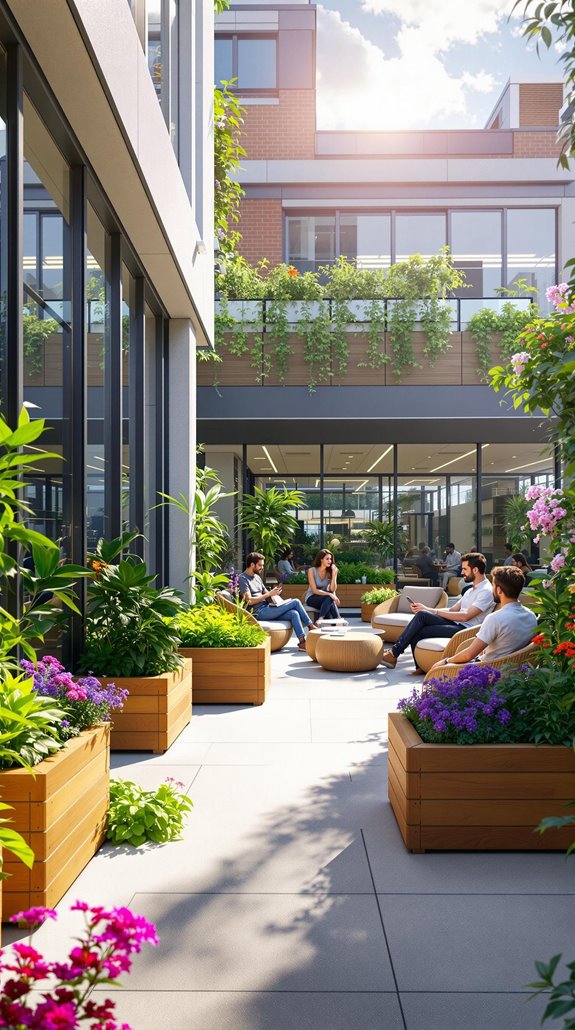
While most corporate environmental initiatives focus on energy consumption and waste reduction, sustainable office gardens deliver triple-bottom-line returns through measurable brand enhancement, cost savings, and regulatory compliance. I’ve seen companies slash water bills by 50% using drip irrigation systems and native plants that reduce replacement costs by 30%. A well-maintained garden can significantly increase property value while attracting the 68% of consumers prioritizing environmental friendliness, all while building employee pride.
Install recycled planters and sustainable tool sets to showcase your commitment. These practices help you achieve ISO 14001 certification, giving you competitive advantages in eco-conscious markets. Professional garden maintenance providers can develop personalized estate management plans that assess your specific site conditions and select appropriate plants and techniques for maximum sustainability impact. With 33% of consumers increasing eco-gardening spending in 2023, you’re positioning your company within a $347 billion market. Your sustainable garden becomes a powerful statement of corporate responsibility.
Seasonal Plant Rotations to Refresh Your Workspace
After establishing your office garden’s sustainable foundation, implementing strategic seasonal plant rotations transforms your workspace into a dynamic environment that maximizes both productivity and visual appeal. I recommend grouping plants by botanical families and creating 3-4 year rotation cycles that’ll boost your yields by up to 48%. You’ll want to follow nitrogen-fixing legumes like beans with heavy feeders such as tomatoes, creating natural fertilizer synergy that reduces costs. Track your planting history digitally to maintain rotation accuracy across seasons. Alternate shallow-rooted lettuce with deep-rooted carrots to optimize soil resources, while rotating flowering nasturtiums with vegetables keeps your workspace visually invigorating. This approach reduces pest outbreaks by 40-60% while creating continuous harvest opportunities that enhance team engagement and belonging. Small office spaces benefit from using raised beds to simplify crop rotation and maintain proper plant family separation throughout the growing seasons.
Conclusion
I’ve shown you nine proven strategies to transform your office with productive outdoor spaces. Now it’s time to act. Start small with one air-purifying plant or herb garden, then expand based on what works. Measure your team’s engagement and stress levels before and after implementation. You’ll need basic gardening tools, plant containers, and a watering system. Pick your first project, set a timeline, and begin creating your productivity-boosting garden workspace today.
References
- https://www.metrikus.io/blog/five-good-reasons-to-have-plants-in-your-office
- https://www.planthropy.co/blog/14reasonsyouneedplantsintheoffice
- https://www.wellable.co/blog/office-oasis-incorporating-plants-healthy-productive-workplace/
- https://www.planteriagroup.com/blog/plants-in-the-office-make-you-15-more-productive/
- https://sustainable.ufl.edu/2021/09/29/action-of-the-month-green-your-office/
- https://blog.naturahq.com/transform-your-workplace-with-strategic-office-plants-placement
- https://mfourgreen.com/from-stress-to-success-the-role-of-plants-in-office-productivity/
- https://www.plantvine.com/2023/11/24/creating-a-welcoming-and-productive-work-environment-with-plants/
- https://thewrightgardner.com/blog/transform-your-office-with-indoor-plant-designs-that-impress/
- https://www.mccoyrockford.com/blog/office-plants-productivity-and-employee-satisfaction/

